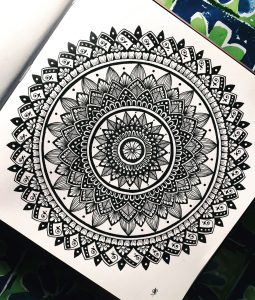25 Aug 2022 ‘Mandala’ Art
GS Paper 1:Indian Culture – Salient aspects of Art Forms, Literature and Architecture from ancient to modern times.
News: Recently, A spectacular ‘Mandala’ art installation, bigger than the size of a football field, was unveiled at a public park in Liverpool in the United Kingdom.

About Mandala:
- Literal meaning of Mandala is the “circle” or the “centre” in Sanskrit.
- Mandala is a symbolic design in Hindu and Buddhist Tantricism for performance of sacred rites and also as an instrument of meditation.
- Mandala patterns are centuries old motifs, used to depict the cosmos.
- Mandala pattern is an interconnected geometric configuration that usually incorporates the circular shape in some form.It can also be in interconnected square form.
- Buddhist missionaries travelling along the Silk Road have taken it to regions outside India. Hence, it continues to appear in Buddhist Thangka paintings.
- By the sixth century, mandalas were recorded in China, Korea, Japan, Indonesia and Tibet.
- Separately, native American peoples are believed to have used the mandala as representation of a deity or the cosmos, and as a spiritual form.
- Besides Mandala’s usage in modern Indian art, it is used in therapy.
How did the Mandala art form originate?
- Mandala imagery first appeared in the Vedas (c. 1500-500 BC): All the hymns of Rigveda are classified in ten classes which are called Mandalas. Mandala indicates cyclical property. There was a strong Vedic tradition to recite Vedic hymns in a cyclical manner.
- Making of Mandala: A Mandala is usually made with careful placement of coloured sand, and accordingly is known in Tibetan as dul-tson-kyil-khor, or Mandala of coloured powders.
What does Mandala represnt?
- Mandala is a representation of the universe, a consecrated area that serves as a receptacle for the gods and as a collection point for universal forces. Men (the microcosm)by mentally ‘entering’ the Mandala and ‘proceeding’ towards its centre, is by analogy guided through the cosmic processes of disintegration and reintegration.
- It is believed that by entering the mandala and moving towards its centre, one experiences a cosmic process of transforming the universe and that of moving from emotions of suffering to the feeling of joy.
- In Hindu philosophical systems, a mandala or yantra is usually in the shape of a square with a circle at its centre.
- A traditional Buddhist mandala is a circular painting that is meant to help its creator discover their true self.
What are the meanings of various elements incorporated within the mandala?
- Eight spokes of the wheel (the Dharmachakra) represent the eight-fold path of Buddhism that brings liberation from the cycle of birth and death.
- The lotus flower depicts balance.
- Sun represents the universe.
- Up facing triangles represent action and energy, and down facing traingles represent creativity and knowledge.
Sources: Indian Express ; NCERT
Source Link:
- Indian Express: https://bit.ly/3DbCjyU


No Comments